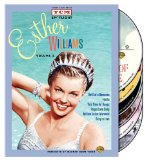| Reviews & Columns |
|
Reviews DVD TV on DVD Blu-ray 4K UHD International DVDs In Theaters Reviews by Studio Video Games Features Collector Series DVDs Easter Egg Database Interviews DVD Talk Radio Feature Articles Columns Anime Talk DVD Savant Horror DVDs The M.O.D. Squad Art House HD Talk Silent DVD
|
DVD Talk Forum |
|
|
| Resources |
|
DVD Price Search Customer Service #'s RCE Info Links |
|
Columns
|
|
|
Esther Williams: Volume 2 (Million Dollar Mermaid, Pagan Love Song, Easy to Love, Thrill of a Romance, Fiesta, more)
More than two years since the first volume was released, Warner Home Video has cherry-picked some more films from MGM mermaid Esther Williams' canon, under their TCM Spotlight banner, for the Esther Williams: Volume 2 collection. Titles include 1945's Thrill of a Romance, 1947's Fiesta and This Time for Keeps, 1950's Pagan Love Song, 1952's Million Dollar Mermaid, and 1953's Easy to Love. As I wrote in my review of the first volume, Esther Williams was a flat-out original as the only star of the "aqua-musical" subgenre, a movie genre one might think today sounds gimmicky or a curiosity piece (and one may be right there, up to a point). But it's important to note that these movies pulled in big numbers at the box office, and while the dramatic or comedic value of the films themselves might be subject to debate, there's no denying the fact that when the scripts momentarily dropped the silly plots to allow Williams to jump into the water and get wet, something magical happened during those incongruously surrealistic, beautiful water sequences.
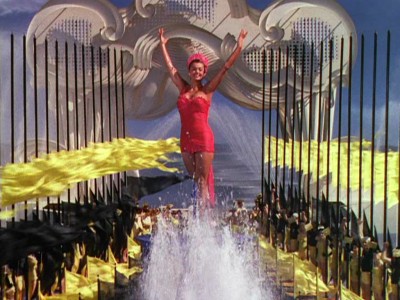
Re-reading my review of that first Esther Williams collection, I don't think there's much I can add to my overall introductory take on this iconic star, so I'm going to port those couple of paragraphs over here, and then I'll have all-new thoughts on this iconic star and this second collection of titles. As with the first group of films released in 2007, watching the Esther Williams: Volume 2 collection on DVD, I can't say that the films included here are any great shakes, at least from the standpoints of directing (except for the Busby Berkeley sequences), writing or even performing - something that Esther herself has made clear in countless interviews and in her wonderful autobiography (most of the production history facts I mention in the subsequent reviews will come from that entertaining, informative book: 1999's The Million Dollar Mermaid). What these films provide is escapism, a Technicolor-soaked journey through improbable comedic, romantic and dramatic situations, as well as elaborate water production numbers that transferred the intricacy of Busby Berkeley's stage choreography, underwater. To a post-world war movie audience still numb from the inconceivable horrors that marked that last "good war," an Esther Williams film must have looked like something from Mars, with its perfectly healthy, happy people carousing in gorgeously hued Technicolor settings, before some surrealistic moment would pop up with Esther swimming around a giant clam or hanging off the rope ladder of a helicopter. M-G-M, hoping to recreate the box-office that 20th Century-Fox had with the Sonja Henie films, melted the ice, threw in Esther, and shot it all in a riot of Technicolor primary color. The world's problems don't intrude in on these films; social unease and political unrest were banished from these fantasy-laden films. I wonder if when the rest of the world saw the time, money and expertise lavished on the typical Esther Williams film, all just for the effect of a gorgeous girl swimming around in a pool, they couldn't help but marvel at the power that Hollywood, U.S.A. wielded. What other country would have the resources and the brash confidence to conjure up such an expensively crafted piece of fluff, while deprivation and sorrow still shadowed most of the earth?
While critics then and now largely sneered at the social myopia in her films, true movie lovers understood what those critics didn't: that expertly-executed fantasy (her swimming scenes, not the films themselves) was just as valid as self-serious dramaturgy (and more potent at the box-office, too). And the utterly ridiculous nature of Esther's poolside production numbers only enhanced the marvelous unreality of these films. It's not only the fact that these sequences are so spectacularly designed and executed - and there would be a major jump ahead in the engineering and aesthetic worth of these Williams water sequences when Busby Berkeley was brought on board, beginning with Million Dollar Mermaid - it's also that I doubt anyone today could duplicate them. Not because we don't have the technology, but because how could you duplicate Esther Williams?
There is something indefinably "magic" about Esther when she swims. Call it star appeal, call it that elusive "X-factor," whatever. She has it. Forget the fact that she's a knockout to begin with, with an adorable, infectious smile that manages to be both erotic and wholesome at the same time: the all-American girl-next-door with the sweet, beautiful face and the pin-up body. There's something else, something in her look; a freedom if you will, a joy at being set loose in the water, that's instantly transferred to the viewer. There's a move that I notice in all of these water sequences, where Esther does this sexy little come-hither shoulder shrug as she treads water, that hits you like a ton of bricks. Who the hell wouldn't want to jump in the water with Esther Williams after seeing that? With her strong, powerful, athletic body moving gracefully through the various aqua-set pieces that distinguish her films, Williams doesn't look like any other major Hollywood actress of her time. Can you imagine Lana Turner, Esther's main competition at M-G-M at the time, and film's leading sex queen, paddling around in the water to the same effect? When critics discuss Williams, quite often they speak of her films as hopelessly "outdated," and they're right. But watching her swim, she herself seems incredibly modern: fit, powerful, and supremely confident. Match that with the powerfully alluring dichotomy she enacts in her films, and embodies in very own physical make-up - the wholesome girl with the killer looks who becomes liberated the minute she hits the water: calling Dr. Freud - and you can see why Williams still provides a surprisingly hefty erotic pull.
Unfortunately, those transcendent moments in the water make watching the "dry land" portions of the five films included here in Esther Williams: Volume 2 anticlimactic. When Esther is swimming, all is right in the cinematic world, but when left to the devices of a studio that didn't go far enough to protect her as an actress, it can be rough going (Williams has often been quoted as saying that all MGM did for her from film to film was change her leading man and the water in her pool). There's an old saw, attributed to many people over the years, that Williams "wet" was a star, but dry.... Well, I found her to be entirely adequate "dry," although again to be fair, these films hardly challenge her as a thespian. Having read her autobiography when it came out, it was apparent that she received little or no true guidance or help from her directors, nor assistance from screenwriters and producers who only wanted an "Esther Williams product." Consequently, when she was on dry land, I never felt that pull I received when watching her swim. Whatever extra spark she had swimming, would dull ever-so-slightly during her traditional dramatic scenes. Certainly Williams herself said she never felt more at home than when swimming, and that an acting career came merely as an afterthought when WWII scotched her bid for the Olympics (Williams was a world-class amateur swimmer prior to movie stardom). That doesn't mean she doesn't try to act in these films; she does. And she's perfectly fine. But Esther Williams is not Esther Williams when dry. It's too bad that M-G-M didn't try and bring that quality out by giving her better co-stars, better scripts, and better directors (or at least, more sympathetic directors). I'll bet she would have blossomed under that kind of care. Let's look at the individual films.
THRILL OF A ROMANCE
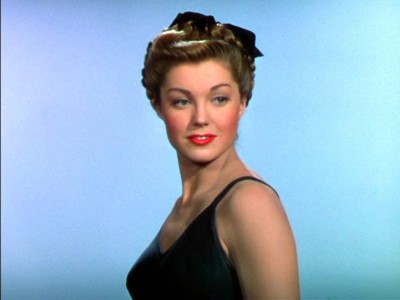
Gorgeous, stacked L.A. public pool swimming instructor Cynthia Glenn (Esther Williams), is spotted one day on the high dive by influential business tycoon Robert G. Delbar (Carleton G. Young). Pumping little swimmer Julio (Fernando Alvarado) for information about his pretty swimming instructor, Robert learns Cynthia's address and begins to methodically pursue her in a manner not at all unlike his calculating business approach. Cynthia lives at home with dotty aunt and uncle, Nona and Hobart (Spring Byington and Henry Travers), both of whom are charmingly "out of it" when it comes to the mechanics of real life (they live on a comfortable annuity, so life is reduced to a series of humorously absent-minded events, like forgetting to mail the gas and telephone bills). Cynthia is swept off her feet by the determined Robert, and soon she marries him. Whisked off to a spectacular resort in the Rockies for her honeymoon, trouble begins that night when Robert is called away to Washington on an important deal...and he actually leaves...before anything happens (as Van Johnson's character correctly states with the appropriate amount of incredulity when he looks the voluptuous Williams up and down, "And he went away and left you?"). Soon, Cynthia can't help but become attracted to handsome aviator hero Major Thomas Milvaine (Van Johnson), who's getting some R & R at the resort, but she's a married woman, so there can't even be a question of whether or not she'll sleep with him. That is...until vacationing Metropolitan Opera star Nils Knudsen (Lauritz Melchior) plays matchmaker for the two beautiful young people.
SPOILERS ALERT!
Williams' second starring role, rushed into production when MGM saw that Bathing Beauty was going to be a big hit, Thrill of a Romance doesn't exactly offer the aquatic thrills that one might expect for a film that was supposed to capitalize on Williams' dynamic swimming prowess. Her few water sequences are confined to a relatively small studio pool; none of them are choreographed with much imagination (in her first sequence, she has to paddle around a crowded pool - sacrilege for a Williams water sequence); nor are any of them outsized or outrageous in their construction or props (no flaming gas jets, no sprinklers, no high dives). And as would be the case with many of her later films, Williams is given a co-star who can't swim in her league. At least the movie makes light of this situation, getting some mileage out of Esther teaching a reluctant Van how to swim. But when they finally do swim together, Van looks distinctly uncomfortable, frequently smiling and laughing apologetically to Williams as he spits out water, trying to keep up with her. Still, Johnson (an actor who was only occasionally asked to do more than be genial...check out his solid dramatic turn in The Caine Mutiny) has a relaxed, easy rapport with Williams that helps keep their clichéd scenes moving, and I would imagine his star power at that time was just as much a factor in Thrill of a Romance's success as was any curiosity for another Williams' aqua-musical. Particularly when Thrill of a Romance has so few water sequences.
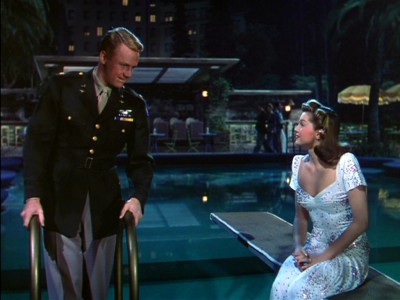
Perhaps because of the rushed nature of the production, we're treated to numerous, largely unrelated musical interludes with Tommy Dorsey and His Orchestra (Buddy Rich gets a nice solo on the drums) and Lauritz Melchior, with some side stops for Dorsey's talented "daughter," Susan (really Helene Stanley) and Jerry Scott. I was particularly impressed with the famous Danish opera star Melchior, who, in addition to that powerful voice, possessed surprisingly adept comedic timing in his first movie outing. If you didn't know he was a professional singer, you might think he was another in a long line of established Hollywood comedic supporting players, such is his facility here (how bizarre, though, is MGM's manner of introducing him to audiences, having his face pop up unexpectedly during the credits, singing at full tilt, only to disappear again?). And one wonders if there was much more to Frances Gifford's and Donald Curtis' subplot about a man-hungry heiress and the punchy professional boxer (they're introduced as significant co-stars...and then they vanish). Frankly, I wish more time had been spent back home with the marvelous Byington and Travers, who are used as merely as bookends for the film. Their dotty act is charming and light, and would have been a nice relief from the constant back-and-forth push-me pull-you antics of Williams' and Johnson (couldn't the screenwriters have thought up a way to get them to the resort, as well, increasing the potential for a true bedroom farce?). Not nearly enough swimming to satisfy Williams' aqua-fans, Thrill of a Romance is otherwise pleasant enough...but frankly, too dry to be of much interest.
FIESTA
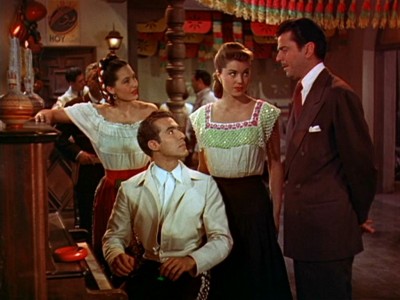
Follow me on this. Mexico's most famous bullfighter, Don Antonio Morales (Fortunio Bonanova) is married to Senora Morales (Mary Astor), who has just delivered twins to the ecstatic father - a boy and girl. Mario Morales (Ricardo Montalban, in his American debut) is ruthlessly trained by his proud-but-overbearing father in the art of bullfighting, but clearly, Mario's interests lie elsewhere...in music composition. Mario's twin, Maria (that's right...Esther Williams is Ricardo Montalban's twin), however, is a whiz in the ring, thanks to the training-on-the-sly by family servant, Chato Vasquez (Akim Tamiroff). But of course, no such future in bullfighting awaits a proper Mexican lady in the all-male bullfighting universe; she will instead be expected to marry scientist Jose "Pepe" Ortega (John Carroll). But first, she secretly sends off one of Mario's compositions to Mexico's most famous conductor, Maximino Contreras (Hugo Haas), who immediately schedules a trip down to the Morales' ranch to meet the extraordinary new composer. However, a twist of fate allows Don Antonio to intercept Contreras without Mario's knowledge, telling the conductor that Mario will be a bullfighter, not a musician. But Contreras won't be put off, and he finally tracks down Mario and tells him of his plan to have Mario study with him - along with telling Mario of his father's deception. Mario leaves the ring - a national disgrace - and the hunt is on to find Mario and restore the family reputation. So how might having a twin factor into this plot, when another bullfighter is needed when the first one runs away?
SPOILERS ALERT!
A ridiculous disaster, according to Williams, with a tortuous, even deadly production, Fiesta is far too unbelievable - even by MGM dream factory standards - to make much of an impression as either a bullfighting film or a "aqua-musical." Indeed, there is only one tiny shot of Esther swimming from a dock out on a lake, to the shore, and that's it for the swimming - a big mistake that MGM evidently, was all too well aware of at the last minute. As for the bullfighting and the limp plot, well...it's all a lot of bull, too. To say that Williams is "miscast" is an understatement. Attempting no accent (a move okayed by the producer even when she voiced concern over the incongruity), Williams doesn't sound or look like Montalban, even in a passing way, but worse than that, she's given little to do here other than to prop him up in his "to bullfight or not to bullfight" plot. For an "Esther Williams vehicle," there's not very much Esther. And once she's made to don that "suit of lights" and that silly wig, the effect is hilariously inept. If the filmmakers couldn't stop from applying obvious lipstick and eyeliner and eyebrows to the gorgeous Williams, couldn't someone have at least suggested taping down her noticeable (and appreciated) bust? As for the snippets of real bullfighting scenes, they are often interrupted with inserts of projection shots of Williams and Montalban, further adding to the silly representation of this art form.
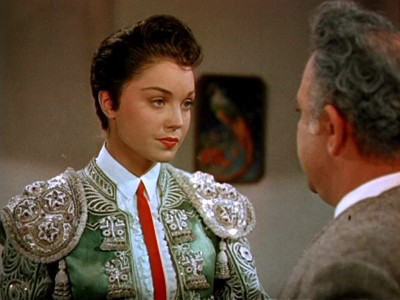
The rest of the film, which seems like a weird, ineffectual hybrid of Blood and Sand and Body and Soul, is entirely devoid of originality or spark, only coming alive once during Montalban's and Cyd Charisse's Flaming Flamenco number (Charisse gets an "Introducing" credit on the original trailer). Ultimately, trying to determine which veteran supporting player looks the most embarrassed became more interesting to me than the actual film. At first I thought it was Tamiroff, who is more subdued than normal here (he really has a thankless role as the loyal servant), but after watching the thinly-veiled contempt on Mary Astor's face in the three or four short scenes she had, I declared her the winner, hands down. Just four short years prior, she had given one of the greatest film noir performances in the genre, for Huston's The Maltese Falcon; to see her sadly reduced here in this mindless dreck is fairly representative of her jiggery Hollywood career. According to Williams' autobiography, Fiesta was host to a never-ending series of production nightmares, including budget overruns, a return of cranky director Richard Thorpe (whom Williams detested after their stint together during Thrill of a Romance), tensions with the locals, Williams' husband landing in a Mexican jail and being expelled from the country, the company's doctor getting shot, and the director of photography and another crew member dropping dead of cholera from the food. It is any wonder, then, that Williams looks pained in her few scenes? With even less water sequences than the previous film, and a ridiculous twins plot that is never believable for a second, Fiesta has to be one of Williams' weakest films.
THIS TIME FOR KEEPS
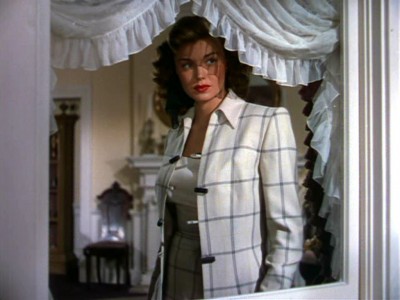
Returning war veteran Dick Johnson (Johnnie Johnston) doesn't want to go back to the opera to sing with his father, Richard Herald (Lauritz Melchior). He hasn't told his fiancé that yet, though; fame-seeking Frances Allenbury (Mary Stuart) is more interested in Dick's last name than in him, apparently (the film never adequately explains why his last name is different than his father's). Seeing an ad for Broadway performer Nora Cambaretti (Esther Williams), Dick remembers back to the trick he pulled on Nora, back at the V.A. hospital when he was recovering from his war wounds. Nora was putting on a swimming and diving exhibition, and Dick began to sing along with the music. Nora, touched by the blind soldier who sang to her, lets him touch her face, a gesture that moves her to the point of giving him a kiss. With this, though, the other soldiers explode in laughter: Dick has been pulling that same gag on other nurses. He can obviously see, as he pulls away his bandages. Remembering this moment, Dick decides to track down Nora and get a job singing in her show. She's not exactly happy to see him (would you be?), but eventually, she begins to fall for the handsome singer, even though she has a steady, Gordon (Dick Simmons of Sergeant Preston fame), and despite the warnings of her pal (who apparently raised her), Ferdi Farro (Jimmy Durante), who's in love with Nora himself. But a trip to scenic Mackinac Island in Michigan to meet Nora's family brings out Dick's little secret: his engagement to Frances.
SPOILERS ALERT!
Slight, with one of Williams' most non-descript co-stars. This Time for Keeps takes a tiny little bit of The Jazz Singer and stretches it uncomfortably into a Esther Williams vehicle, to little effect. With the exception of one good aqua-cade sequence, some excellent location shooting on beautiful Mackinac Island, and one or two fun songs my Jimmy Durante, This Time for Keeps is hardly a memorable Williams outing. The biggest problem I had with the film is the Dick Johnson character, and the fact that he's never called to account for how he treated Nora when they first met. A cruel joke, tricking her into thinking he was blinded during the war (a movie joke I would imagine some WWII vets didn't find too funny when watching the film), it makes the character unsympathetic right off the bat, and rather nasty, too, when you think about it - a bad first impression that's hard to shake, particularly when he never says he's sorry about it. He just looks her up again and begins their romance. It doesn't help, either, that Dick is played by the colorless Johnnie Johnston, a slight, bland singer who can carry a tune well enough, but who seems no physical match for the strapping Williams. Never at all passionate in his pursuit of Williams (Johnston seems strangely above it all and disengaged from the proceedings), he isn't even allowed to paddle around once with Williams. And without a seemingly committed romantic partner to chase Williams, what, exactly, is This Time for Keeps in service of, then?
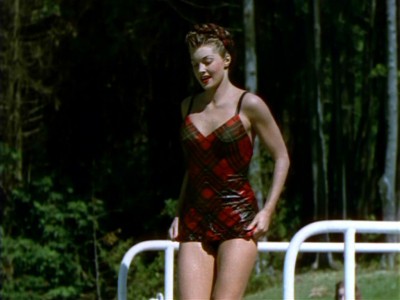
The rest of the cast is hit and miss, as well. Durante, whom I never found all that funny before in the movies, plays it a bit straighter here, but his unresolved romantic love for Williams is handled in a most oblique manner (as if the filmmakers knew it would be mighty uncomfortable to try and enact that scene between the two performers), and his character soon recedes into second-banana status, punching up scenes with some admittedly fun numbers like signature tune Inka Dinka Doo, and I'm the Guy That Found the Lost Chord (particularly well done here), before disappearing altogether. Lauritz Melchior, who was so good in a comedic role for Williams' Thrill of a Romance, is badly used here as a dramatic, paternal figure, with nary a double-take or resigned rimshot to fall back on; too bad they didn't make his slight role more fun. And who can complain about the dynamic Xavier Cugat and His Orchestra, whenever he shows up to jazz up the joint? The location work in Michigan is beautiful, and Johnston and Williams have a nice sleigh bell ride, singing S'nNo Wonder They Fell in Love, but it's too little, too late, to save the wispy thin This Time for Keeps.
PAGAN LOVE SONG
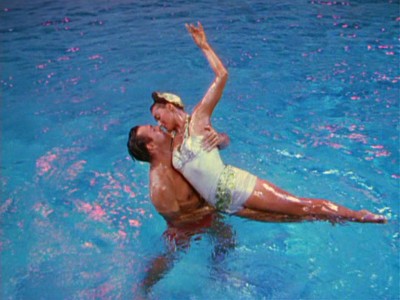
Half-Tahitian beauty Mimi Bennett (Esther Williams) is finally going to do it: she's leaving Tahiti to go to America. Her aunt, Kate (Minna Gombell) has heard this song and dance before, but this time, it's apparent that Mimi is determined to leave behind the island paradise for the more industrious United States. Arriving on the boat that will take her away is Hazard Endicott (Howard Keel), a breezy, carefree school teacher from Springfield, Ohio, who has inherited the "Endicott Plantation." Intent on living off the riches of his newly-found wealth to become a late-in-life beachcomber, the brash Hazard spots the beautiful Mimi when she greets his boat, and tries to hire the island girl for his housekeeper...and perhaps more. Mimi keeps the charade going that she doesn't speak English, but eventually, she lets Hazard in on the joke. The other joke played on Hazard is the "Endicott Plantation." Little more than a grass hut in a sea of onion grass, if Hazard wants to make any money, he's going to have to enlist the happy, fun-loving natives in harvesting copra from coconuts. But housekeepers Tavae (Charles Mauu) and Terru (Rita Moreno) have a hard time keeping their minds on work when the big fete is approaching, while Hazard has his hands full with the three little children who have adopted him. Will Hazard stay in Tahiti, and will Mimi leave?
SPOILERS ALERT!
Considered another forgettable trifle by critics and fans of Esther Williams, I found Pagan Love Song to be just...right, actually. Produced with the assured hand of MGM musical legend Arthur Freed, Pagan Love Song is short (only 76 minutes - barely feature-length), sweet, and to the point. It comes in and tells it little story with charm and a dash of wit, and it gets out before you have time to question the logic of it all. In other words, it's perfect escapist entertainment, gorgeously shot on location in Hawaii (in Technicolor, of course), with attractive stars who look like their having a vacation rather than making a movie. And the film has a sense of humor about itself. It's witty without being broad (I love it when Williams, pretending she doesn't speak much English, asks Keel what a "broken down beachcomber" means), but its story isn't central, either, to the experience of just musing on the scenery and listening to the pretty people singing the sweet, pretty songs.
I would imagine that some today might find fault with the film's deliberate refusal to discuss Mimi's mixed racial heritage (as opposed to something like South Pacific), but I took that more as the film not particularly caring about that aspect of her character - and what a welcome attitude that is in the film. There are no heavy, serious scenes of misunderstandings between Mimi and Hap over their cultures; any commentary on the differences between how mainlanders and Tahitian live and work and feel, is treated lightly and comically. When Mimi defends mainlanders, saying they've done "some pretty wonderful things," like "sending over the missionaries to teach us how to live," Keel counters lightly that maybe it's time to return the favor: the city folks could now learn from the Tahitians. Nothing heavy. Nothing overt. Just two trains of thought thrown out there, and the scene moves on. In the film, the Tahitian natives would rather party than work - and why shouldn't they? And soon Hap understands that's the Tahitian way; it is, after all, the kind of life he said he always wanted when he first arrived on the island. In the end, the natives remain true to their inner spirits; it's Hap who changes (even though the easy-going Hap doesn't have far to travel to the Tahitian way of life). He accepts the inevitable that the children of the village can live with whomever they want, and the three cute kids that adopt him soon become his children. And he eventually accepts the fact that the natives view work and play and industry quite differently than he does - again, though, there's not much difference between the natives and the breezy Hap - so he adapts to their way of thinking. All of this is handled in a very off-handed, even throwaway manner; if you choose to see it and pick it out, fine - but the movie doesn't push it in your face. Pagan Love Song wants to entertain you, not lecture you.

I particularly liked big, handsome Howard Keel matched up with Esther here (especially after the limp, flyweight Johnnie Johnston). One of my favorite 50s musical stars, Keel fits this story perfectly, with that powerful, controlled baritone used to good effect in fun songs like Singing in the Sun and The House of Singing Bamboo. He's seems to know this is all a lark, and he takes to the role the same way, keeping things light and airy and off-hand (he swims much better with Williams, as well, than previous co-stars). As for Esther Williams, I'm not sure if she ever looked better on film than she does here, with her deep tan and those pretty wrap dresses showing off her delectable curves and pretty face. As well, she looks more comfortable mixing it up with the confident Keel; her energy level is considerably higher here than in the previous outings. And thankfully, there's more swimming in Pagan Love Song, with Esther getting a gorgeous finale, complete with strikingly-designed, stylized sets, where she reenacts the Huahine story of the Tahitian island disappearing into the sea each night as the sun goes down. Simply inserted into the film as a fantasy of Hap's - the best way to do such a scene without making the motivations for its insertion into the "real" story ridiculous - this finale has Esther swimming underwater among spectacularly colored coral, while Keel, dressed in native garb, surveys the scene from a cliff, with a dramatic, red-and-black-tinged sky behind him. I was especially struck with the special effect that introduces Keel's fantasy: he sees Esther swimming in the sky, right in front of him. It's still an impressive shot, over fifty years later, and yet another indication that Pagan Love Song is an overlooked little gem in the Esther Williams canon.
MILLION DOLLAR MERMAID
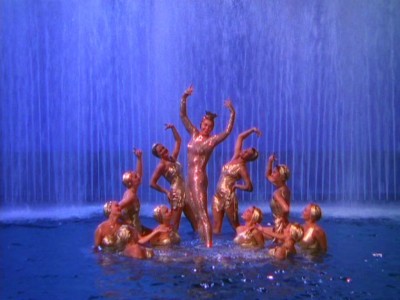
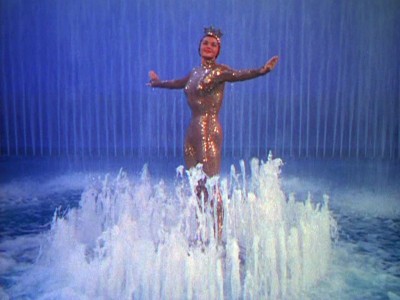
Telling the highly fictionalized biography of Australian swimmer and proto-feminist Annette Kellerman, Million Dollar Mermaid begins in Australia, where little Annette (Donna Corcoran) is confined to leg braces. Her father, Frederick Kellerman (Walter Pidgeon), runs a conservatory of music out of their house, but the busy father is unaware that his daughter is going to a nearby lake everyday to swim in the hopes of beating the odds with her crippling disease. Once he discovers this, he embraces the child and tells her he'll help her in any way he can, and soon, Annette (Esther Williams, all grown up) is winning trophy after trophy for competitive swimming contests. Unfortunately, economic conditions in Australia force the Kellermans to move to England, where Frederick has accepted a position to work at a conservatory. But upon arrival in London, he discovers the conservatory has closed, with the father and daughter team virtually penniless. Luckily, Annette can hock her trophies, and Frederick can teach music lessons, but huckster James Sullivan (Victor Mature), who met the lovely Annette on the boat over to England, has other ideas for the swimmer. He wants her to swim across the Thames, but she ups the ante to swimming down the Thames...for 26 miles to Greenwich. This amazing feat brings her international attention, and she's soon on her way to a career in professional exhibition swimming. But the waters are choppy for her romance with the hustling Sullivan.
SPOILERS ALERT!
Probably the most recognizable title in her oeuvre, Million Dollar Mermaid certainly was the most memorable film for Williams (according to autobiography), not only because she had an exciting, liberating affair with her leading man, Victor Mature, but more importantly, because she cheated permanent paralysis (and probably death) when she broke three vertebrae in her neck during her spectacular dive off a six-story platform in the film's Busby Berkeley finale (the film was shut down for six months as she languished in a body cast). The film itself hasn't worn well all these years later, no doubt due to the lugubrious direction of squaresville Mervyn LeRoy (who admitted to Williams that he only took on the film to get a big hit under his belt). If there's anything to recommend it, the spectacular aqua-numbers staged by the peripatetic Busby Berkeley, and the smooth chemistry between Williams and Mature, would be about it.
Critics often mention the fictional elements that dominant the story, but anyone expecting historical accuracy in a Hollywood bio-pic has got to be kidding themself. Indeed, the "historical" scenes of the film could be lifted from any bio-pic from that era, with that familiar abbreviated "cliff notes" approach to the drama that aims to suggest a superficial "highlights" overview of a famous life, rather than truly examine it or comment on it. Once Mature enters the picture, his natural energy certainly jacks up the proceedings - and it's obvious that Williams enjoys working with him, too - but unfortunately, he exits the picture for a long stretch during the second act, and only comes back towards the end. And that just leaves the "Fountain and Smoke" number staged by Berkeley...and that sequence alone is worth the price of admission for Million Dollar Mermaid. According to Williams' bio, Berkeley, who had a serious drinking problem, hadn't directed a film since he was fired from Esther's earlier picture, Take Me Out to the Ball Game. Unhappy with the professionally distant LeRoy, who refused to give any direction to his actors other than to say, "Let's have a nice little scene," Williams apparently requested Berkeley as director for the aquatic numbers. It was a fateful choice, in more ways than one.
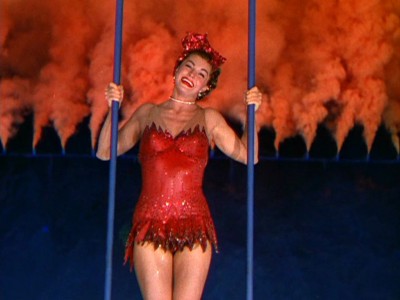
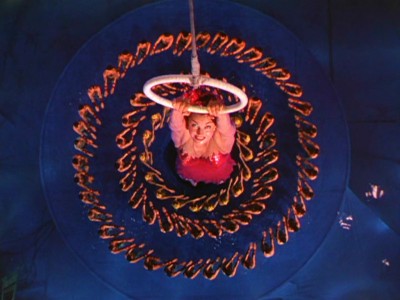
If a fan of Esther Williams had to conjure up one cinematic image of the aqua-star that best represented her, a good bet would be the shot in Million Dollar Mermaid of Williams, clad entirely in gold sequins and crown, riding a Lucite elevator platform to the height of sixty feet, and then diving off it. Indeed, that epic, over-stimulated, over-stylized structuring of swimmers, divers, props such as huge swings suspended high over the water, or water jets, or colored smoke, into a surreal, organic dream of visual poetry married to the physical exuberance of daring athleticism, is the absolute hallmark of both Berkeley's aesthetic vision, and Williams' iconography. Quite simply, Williams needed a Berkeley to unlock the potential of her unique talents. As a straight dramatic actress, Williams wasn't given the kind of material or direction that would stretch her capabilities, but in the water, she could do what no one else in Hollywood could do. That's why the aqua-numbers stand out in people's memories, and why the other elements of her films, while pleasant enough, fade away. Berkeley used Williams like another prop in his visual schematic, but she's an articulated prop that performs stunts and feats that others couldn't duplicate. Match that with her physiognomy - she's a vision of beauty and strength - and you have a complicated extension of visual fantasy, both in how she looks and how she performs. It's a remarkable marriage of director and performer unlike anything else in cinema. And the first time we truly see its full flowering is here in Million Dollar Mermaid. This unique collaboration would reach another peak of brash visual exuberance in Easy to Love.
EASY TO LOVE
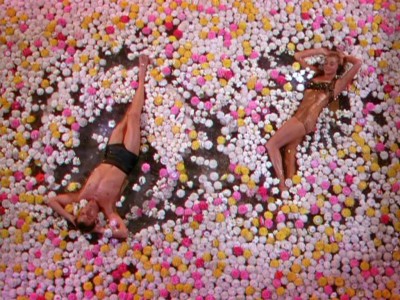
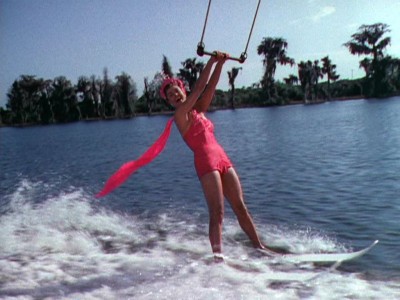
Cypress Gardens owner and all-around business tycoon Ray Lloyd (Van Johnson) works his star attraction, Julie Hallerton (Esther Williams) to death. Not only is she the central performer in his spectacular aqua-shows, she also poses for tourist pictures in the beautiful gardens, and she acts as his secretary...all for seventy-five measly bucks a week. But, she does all of this because she loves him. Oblivious Ray, though, keeps a hands-off approach with all the beautiful girls who work for him...especially Julie. Fed up with being used in such a cold way, Julie threatens to quit and leave with handsome hunk swimmer Hank (John Bromfield) until Ray promises a get-together in New York City. Expecting a vacation, Julie is crestfallen when she discovers the trip is just another excuse for Ray to work her (in a print ad), so she decides to flirt it up big-time with the singer featured in the ad: Barry Gordon (Tony Martin). Deciding to leave Ray again, this time to work on Broadway when Barry gets her an audition, Ray manages to soft-sell Julie back to Florida...but he wasn't counting on Barry following Julie back to Cyprus Gardens.
SPOILERS ALERT!
A couple of nice numbers from smoothie Tony Martin, beautiful location work down in Florida, and one or two good comedy moments all add up to a slight but pleasant vehicle for Esther, but when you factor in the gigantic aqua-cade stunt sequence finale, Easy to Love moves up a notch in the Williams' collection. Directed by choreographer-turned-director Charles Walters, Easy to Love's romantic comedy complications certainly aren't original or even particularly memorable here, but they're competently handled by the director (Walters knew how to move the camera around; watch Martin's Did You Ever musical number), and the performers seem up to the challenge. I particularly liked Tony Martin's easy song-stylings (he's got a beautifully easy, modulated delivery) and funny double-takes (he has a funny moment when he nods conspiratorially at his rivals), and he gets a couple of good numbers here, including Did You Ever and That's What a Rainy Day is For (with a humorous chorus of old ladies mooning over Tony). As for Esther, she's a bit more fractious here than normal, and it suits her. Getting drunk and yelling at the men who let her down looks good on the beautiful Williams; it's a pity MGM always tried to make her so wholesome in her films.
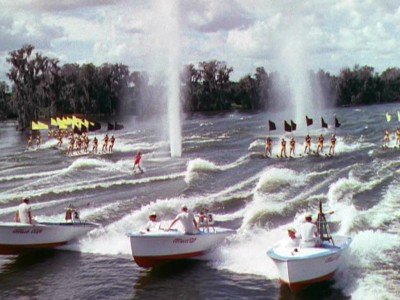
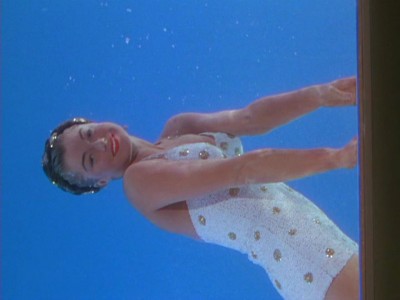
Easy to Love's big selling point, though, is the grand finale directed by Busby Berkeley. On an epic scale surpassing anything he had attempted before, the waterskiing aqua-cade gymnastics on the ocean, using a huge phalanx of skiers behind the beautifully-costumed Esther (holding her own with world champion skiers), all drawn by white boats with white-costumed skiers, is still an amazing sight. Add to that the orgy of movement he layers onto the action, including huge, exploding geysers of water shooting out at over sixty feet, skiers jumping over ramps, and incredibly, Esther picked up off her skis via helicopter (!) only to jump and dive off the rope swing at eighty feet...while the copter is still flying and while the skiers are still skiing (Williams clearly states she did not execute this crazy-dangerous stunt; stunt diver Helen Crelinkovich gets the credit), is nothing short of miraculous. I have a handful of kids who are saturated on CGI special effects crap, and they were suitable impressed when I showed them this scene. The final image of Williams, high on a platform as the camera pulls back, revealing rippling red flags and jets of water, looks like Leni Riefenstahl Meets Walt Disney, as directed by Busby Berkeley, and it's an incredibly exhilarating moment. Forget all the silly nonsense in Easy to Love's movie proper; forget all the fluff stuffed inbetween the gorgeous swimming scenes (earlier, Berkeley engineers a remarkable moonlight swim with Esther and Bromfield, meeting in a sea of floating flowers, as they turn on giant lazy susans, kissing at the end - unbelievably erotic and surrealistic) - this is escapist Hollywood dream factory engineering at its most brash, its most dynamic, and its most voluptuous. You couldn't execute a scene like today because the audience would sneer at it; they'd take it as camp or a spoof. But in 1953, this was enjoyed exactly for what it was, and for me, it's just as important a moment in classical Hollywood filmmaking as any other example one might choose from more "important," seminal films.
The DVD:
The Video:
To collectors, probably the first question they're going to have about the Esther Williams: Volume 2 collection is whether or not the Technicolor looks out of register. There are individual shots here and there that do look off. Thrill of a Romance has the most - only three or four - which are noticeably off synch. To me, Fiesta looked a tad muddy, while Million Dollar Mermaid has some print damage at the beginning, while overall it looked somewhat dark, as well. Generally speaking, though, these look as good as one could expect for unrestored Technicolor elements. If they've been digitally enhanced, that's one thing. But nobody went back to the vaults and struck new prints - if that's even possible with the surviving elements. So, my guess is you won't see better transfers of these full-frame, 1.37:1 images anywhere else, anytime soon.
The Audio:
The Dolby Digital English mono soundtrack accurately represents the original theatrical presentation of these films. All dialogue is cleanly rendered. Hiss is noticeable, but not distracting. English subtitles and close-captioning are available.
The Extras:
Each film in the Esther Williams: Volume 2 collection has a few extras included, helping you get in the mood for a typical night at the movies in the mid-to-late 40s and early 50s. A short subject or two, and a cartoon, as well as the film's theatrical trailer, are included, while a few films have alternate, deleted scenes that didn't make it into the final cut. On the Thrill of a Romance disc, a John Nesbitt's Passing Parade short entitled, The Great American Mug, is included. It runs 9:43, and it looks at the barbershops of the past (as usual with these Nesbitt shorts, sentimentality and sharp writing rule). There's a Droopy cartoon included here, Wild and Woolfy, directed by the genius, Tex Avery, that runs 7:36, while Outtakes include musical numbers Gypsy Mattinata, I Should Care, and Please Don't Say 'No' (total run-length: 6:43). Thrill of a Romance's original trailer is included. On the Fiesta disc, another wonderful, sentimental John Nesbitt's Passing Parade short is included, running 10:27, entitled, Goodbye, Miss Turlock, a beautifully written piece about the disappearance of the one-room schoolhouse, and the dedicated school marms who ran them. A Junior and George cartoon, Hound Hunters, directed by Tex Avery, is included. It runs 7:17, and it looks to be a bad video copy (a little surprising there). Fiesta's original trailer is included. On the This Time for Keeps disc, a Technicolor Pete Smith Specialty entitled Now You See It, runs 9:22, and shows off the latest developments (circa 1946) in macro-photography. A classic Tom and Jerry cartoon, Dr. Jekyll and Mr. Mouse is included, running 7:24, while an musical outtake, Little Big Shot sung by Jimmy Durante, is also included (2:09). This Time for Keeps' original trailer is included. On the Pagan Love Song disc, a black and white Pete Smith Specialty short, Curious Contests, runs 8:26, and looks at oddball contests like baby changing races and pie eating contests. A hilarious Droopy cartoon, The Chump Champ, runs 7:15 ("Kiss me, King!" - a classic), while Outtakes for musical scenes Why is Love So Crazy, Tahiti, versions 1 & 2, Music on the Water, The Sea of the Moon, and The House of Singing Bamboo run 14:46. Pagan Love Song's original trailer is included. On the Million Dollar Mermaid disc, a black and white Pete Smith Specialty, Reducing, is included; it runs 8:20. A cute, classic Tom and Jerry cartoon, Wise Little Quacker, runs 7:06, while an audio-only version of Million Dollar Mermaid, performed for the Lux Radio Theater, and starring Walter Pidgeon, is included (the audio is really difficult to understand). Million Dollar Mermaid's original theatrical trailer is included. And on the Easy to Love disc, a boring Dr. James A. Fitzpatrick TravelTalks short, in faded Technicolor, looks at the Romantic Riviera. In the short, he pronounces it, "Ree-vee-era." It runs 8:36. There's a great Barney Bear short (I love Barney Bear), Cobs and Robbers, that runs 6:20, included here. And the Easy to Love original trailer is tacked on, as well.
Final Thoughts on the Box Set:
While you couldn't say that any of the films collected on the Esther Williams: Volume 2 set are "classics" in the sense of "great movies," they are, for the most part, quite skillful escapist entertainments in their own right. And once we get to the Busby Berkeley-directed sequences in Million Dollar Mermaid and particularly, Easy to Love, we're in Dreamland, MGM Hollywood-style: a riot of stylized, surrealistic motion and color graced by the kinetic presence of that aqua-action star, gorgeous Esther Williams. And that's enough for me any day. I highly recommend the Esther Williams: Volume 2 collection.
Paul Mavis is an internationally published film and television historian, a member of the Online Film Critics Society, and the author of The Espionage Filmography.


|
| Popular Reviews |
| Sponsored Links |
|
|
| Sponsored Links |
|
|
| Release List | Reviews | Shop | Newsletter | Forum | DVD Giveaways | Blu-Ray | Advertise |
|
Copyright 2024 DVDTalk.com All Rights Reserved. Legal Info, Privacy Policy, Terms of Use,
Manage Preferences,
Your Privacy Choices | |||||||









